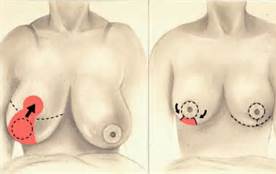Breast Reduction: Ranks High in Patient Satisfaction
March 30th, 2015
 Just as some women may experience a decrease in breast size over time, some will notice an increase in breast size, others simply want a change. When a woman is uncomfortable with having too much breast tissue, there are several options to correct this condition. A dramatic increase in size may have resulted due to an increase in overall weight gain or a pronounced sagging of the breast tissue. As we’ve discussed in earlier posts, overly large breasts may cause physical discomfort, including symptoms like neck pain, back pain, shoulder grooving and irritation beneath the breasts. Patients routinely turn to breast reduction or breast lift surgery to reduce their symptoms, along with their breast size and or position. Patient satisfaction rates are particularly high for this cosmetic surgery. Reducing breast size can be done with direct surgical removal of breast tissue or by using liposuction. Liposuction is effective only when there is a significant amount of fat in the breasts. Liposuction does not adjust nipple position, which requires removing and re-positioning the nipple.
Just as some women may experience a decrease in breast size over time, some will notice an increase in breast size, others simply want a change. When a woman is uncomfortable with having too much breast tissue, there are several options to correct this condition. A dramatic increase in size may have resulted due to an increase in overall weight gain or a pronounced sagging of the breast tissue. As we’ve discussed in earlier posts, overly large breasts may cause physical discomfort, including symptoms like neck pain, back pain, shoulder grooving and irritation beneath the breasts. Patients routinely turn to breast reduction or breast lift surgery to reduce their symptoms, along with their breast size and or position. Patient satisfaction rates are particularly high for this cosmetic surgery. Reducing breast size can be done with direct surgical removal of breast tissue or by using liposuction. Liposuction is effective only when there is a significant amount of fat in the breasts. Liposuction does not adjust nipple position, which requires removing and re-positioning the nipple.
Traditional breast reduction surgery reduces breast size through excision of breast tissue, while repositioning the nipple and areola (pigmented skin around the nipple). The size of the areola can also be reduced. Breast reduction scars, which are similar to breast lift surgery, are placed around the nipple and beneath the breast as well. Scars will be less noticeable as they continue to heal. I recommend any breast tissue that is removed should be sent for examination by a pathologist. This laboratory examination includes a visualization under a microscope after tissue staining, to determine the presence of conditions or abnormalities which might increase chances of breast cancer. On rare occasions, breast cancer is diagnosed this way.
Our patients choose of their desired final breast size, based on decisions made during our office consultation, unless insurance is being considered. A range of implant “sizers” are helpful in this regard. The appropriate time to schedule reduction surgery following pregnancy is determined by normal involution of breast tissue and the end to breast-feeding. Generally this takes six months to a year after delivery or three months after ending breast-feeding. There is a possibility that some women will not be able to breast feed again after breast reduction surgery. Therefore, if breast-feeding is an important consideration, we advise our patients to postpone breast reduction surgery until they are finished having children. According to statistics provided by the American Society of Plastic Surgeons (ASPS), more than 120,000 patients have chosen breast reduction/ lift surgery last year.
Breast Asymmetry: What to do about it?
January 13th, 2015
Breast asymmetry is a very common concern among women, adolescents and adults alike. No one is born with perfectly symmetric breasts and mild to moderate differences in breast shape, or a 1-2 cup size difference, or position in the developing adolescent are to be expected. Moreover, breast asymmetries that persist beyond puberty affect more than half of all women! In fact, one study in the Plastic and Reconstructive Surgery Journal, out of 100 women who wanted breast augmentation with implants, 88 percent had natural asymmetries. At a time when our body and mind are changing rapidly, when is breast asymmetry a cause for concern? Having uneven breasts may impact a young woman’s body image. Let’s review the pros and cons of surgical intervention with an emphasis on newer techniques such as using lipo-suctioned fat to correct asymmetry, called fat transfer.
A recent study published in the December issue of the Plastic and Reconstructive Surgery Journal highlights the psychological impact of breast asymmetry on adolescents. The study suggests that patients with breast asymmetry have poorer emotional well-being and lower self-esteem than their female peers. This is not a surprising revelation given that high rates of breast dissatisfaction have been reported within the adolescent female population, especially during early adolescence when there is greater variance among peers. Psychological issues are important in this group of young women, and these issues include social embarrassment, low self-esteem, depression and isolation from classmates. Problems that occur relate to sexual relationships and cultural beliefs. The majority of these patients are young, healthy individuals, and the psychological and social impact of these conditions is significant. Physicians and parents should be aware that seemingly small differences to an examiner’s eye might have a considerable impact on the sometimes fragile psyche of an adolescent.
Surgical options for correction exist. These include improving breast symmetry by combining different techniques using implants, autologous or your own fat transfer, liposuction, breast reduction and/or myocutaneous flaps. Correction of breast asymmetry often involves multiple surgical procedures. The best policy is early intervention with education, support and counseling. The key steps in successful management are diagnosis, appropriate referral, counseling, optimal timing of surgery and avoiding unnecessary surgery in a developing young adult. In the rare instance that the asymmetry causes such distress that your doctor recommends surgery, please consult with an experienced plastic surgeon about your options for surgery.
Newer techniques such as autologous fat transfer, offer a less invasive way to correct breast asymmetry with more natural appearing results. Fat grafting is natural, flexible and versatile. It allows the plastic surgeon to gradually sculpt and reconstruct the breast to a natural looking shape and feel. Like other reconstructive techniques, fat grafting is a staged procedure with results achieved over time. Fat is harvested from the abdomen, flanks and thighs and then is injected into the breasts through small incisions. This is an outpatient procedure, with each stage carried out every 3 to 6 months. The number of stages required for completion varies on an individual basis. The results are long-lasting and the patient also receives the added benefit of liposuction at the donor sites.

